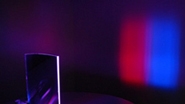Microsoft develops 3-D auto-stereoscopic display prototype

The Microsoft Applied Sciences Group has developed a new “wedge lens” that lets viewers see 3-D content without special glasses. According to the website Ars Technica, the new lens is thinner at the bottom (about 6mm) than at the top (11mm) and steers light to a viewer’s eyes via LEDs along its bottom edge. The 3-D display uses a camera to track viewers so it knows where to steer the light; the idea isn't new, but the required CPU power is now affordable and small enough to pull it off on a large scale.
Various companies have shown off 3-D displays that don't require glasses, but those sets often use lenticular lenses, which are integrated into the display and project different images in two fixed directions. As a result, the viewer needs to be in a designated zone to experience 3-D. Microsoft's prototype display, however, can deliver 3-D video to two viewers at the same time by presenting different images to their left and right eyes (one video for each), regardless of where they are. It can also show ordinary 2-D video for up to four people simultaneously (one video for each person).
Traditional lenses found in projectors sit between a point of light and its focal point, which is why viewer-tracking 3-D systems are often bulky. Ars Technica reported that the design of Microsoft’s wedge lens bypasses this problem, because the light is traveling within the lens and not in the air (the focal point is thus the flat surface of the wedge), minimizing the distance between the projector and the screen. The LEDs control the position and angle of the light as it enters the bottom edge of the lens and, as a result, the direction the light comes out. The viewer-tracking cameras, meanwhile, collect light traveling the other way through the lens. The system's viewing angle is about 20 degrees, but Microsoft hopes to tweak the lens design and increase it to 40 degrees.
Because the lens is thin, it can be incorporated into a standard LCD, replacing the traditional backlight; light from the lens shines through the liquid crystals to project the images to viewers. Picture quality is limited by the screen's refresh rate, and so Microsoft is pushing display manufacturers to make faster LCDs. Separately, the company is looking into how the lens can be used as the backlight of a laptop that can project images to either one person or to multiple people.
The professional video industry's #1 source for news, trends and product and tech information. Sign up below.
